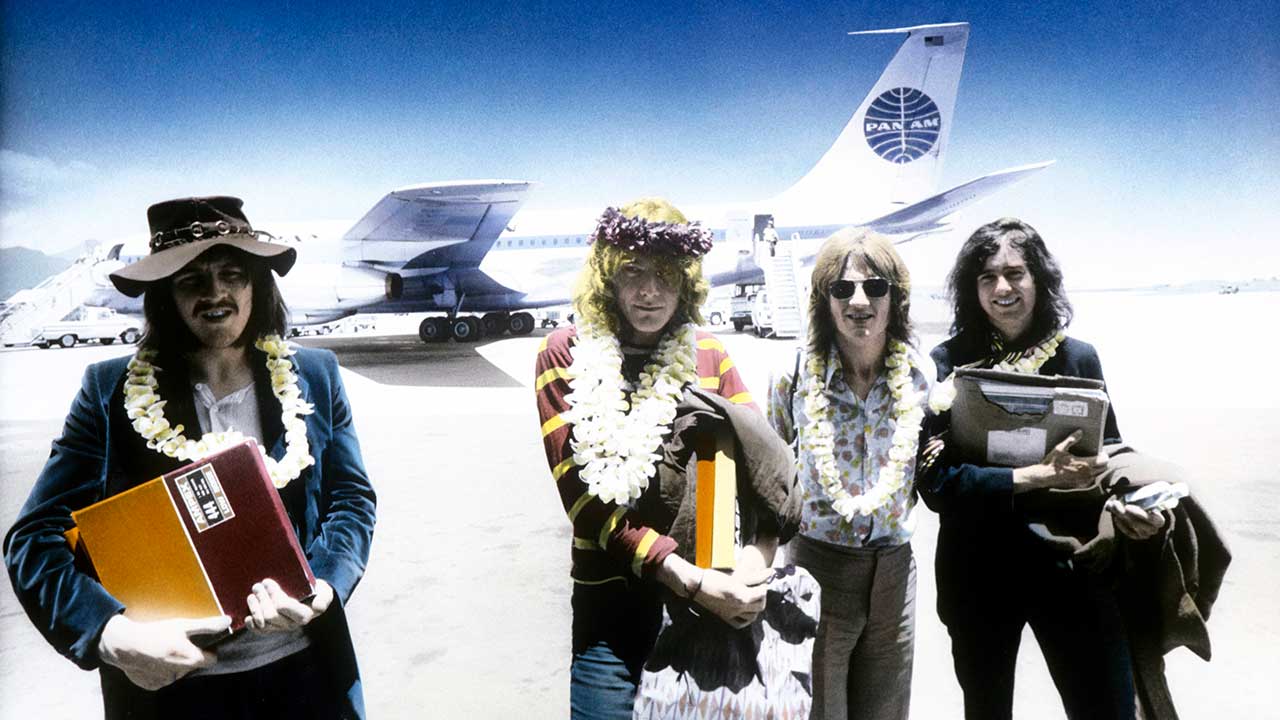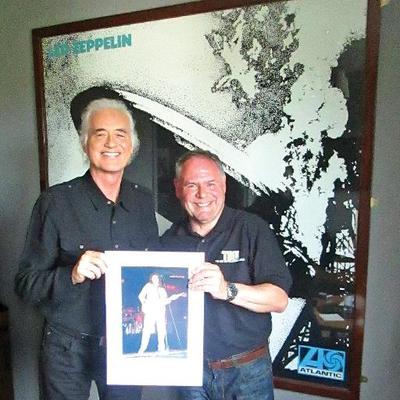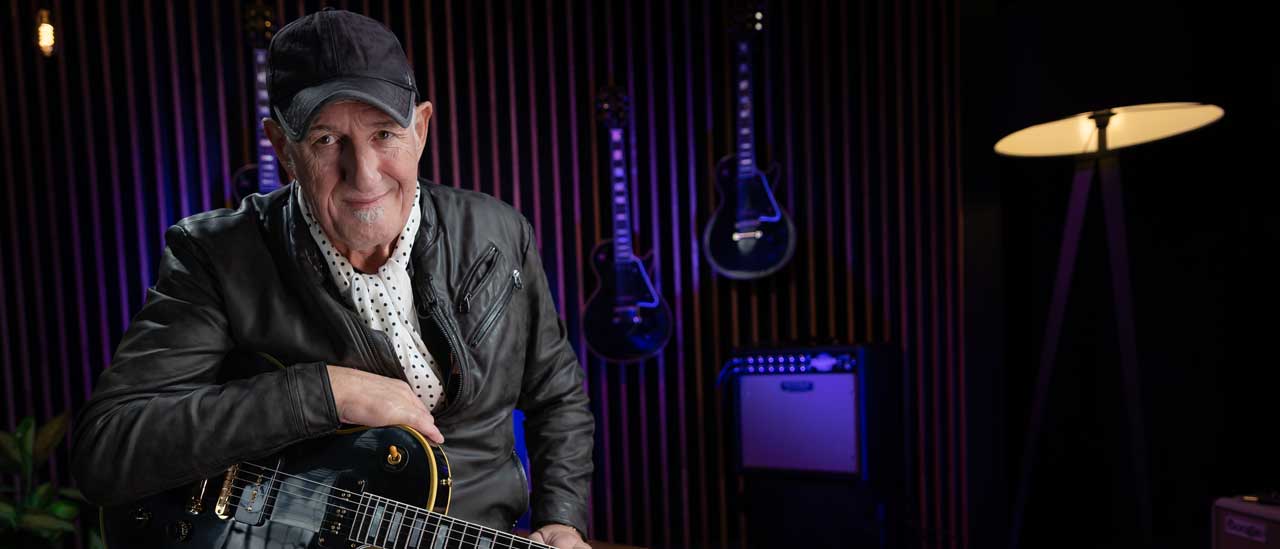How Led Zeppelin II changed the face of rock music
Led Zeppelin II would dislodge The Beatles’ Abbey Road from the top of the US chart and go on to shape the the craggy face of modern rock music

When Jimmy Page formed Led Zeppelin out of the ashes of The Yardbirds in late 1968, the guitarist could never have envisaged the success his new band would enjoy in their first year together.
Zep’s debut album was released in the US in January 69 and quickly climbed the Billboard chart off the back of their debut tour there. Its UK release (in March of the same year) gave them a belated boost in their homeland, aided by a series of club gigs and some well-received BBC radio sessions. But it was Zep’s second album that truly defined the band – and moulded the entire genre of rock music itself.

Led Zeppelin II was a twisted, swaggering beast of a record, born out of the experiences the four-piece (Page, along with singer Robert Plant, drummer John Bonham and bassist John Paul Jones) were gaining from being part of, to coin a Spïnal Tap-ism, a living, breathing rock band on the road.
It was in the US that Zeppelin first really made their mark, and their label (Atlantic Records) was anxious to reap full benefit from what was fast becoming their biggest dollar earner since Cream. Zeppelin’s astute manager Peter Grant also saw the vast potential in his band and the momentum they were building, and was happy to go along with Atlantic’s call for a second album to be released by late summer 69.
All this hurled Zeppelin into a hectic period of touring and recording commitments that, by the year’s end, would establish them as the most important and fastest-emerging band on the scene, and rivalling The Beatles and the Rolling Stones in record sales and box office receipts.
Fuelled by the gruelling stint on the road, and the chemistry so apparent in their live shows, Page and his bandmates began formulating ideas for their second album. The first batch of recording sessions took place at Olympic Studios in Barnes, west London, in April 69. It was the same place where they had recorded their debut album in a little over a staggeringly quick 30 hours.
But the sessions for what would become Led Zeppelin II would not prove to be quite so fast. The initial recording sessions saw the band working on What Is And What Should Never Be, a drifting, melodic song that would highlight Robert Plant’s growing maturity as a lyricist, and Whole Lotta Love – the song that would soon become their onstage anthem – led by Page’s distinctive, stuttering guitar riff that would later change the face of rock forever.
Sign up below to get the latest from Classic Rock, plus exclusive special offers, direct to your inbox!
But their time in Olympic Studios was limited, and by the end of the month Zeppelin were back on the road in America. Atlantic Records were so keen for a second album, though, that they informed Peter Grant that the band should continue recording during their second US tour. Unbeknown to the group, label executives were aiming ambitiously for a July release date.
While Grant was happy for the sessions to re-commence, thankfully he did not buckle to Atlantic’s scheduling demands – and this would prove to be the first of many occasions when the formidable figure of Peter Grant, rather than the record company, dictated how Zep would conduct their business.
During the US tour, the band began road-testing some of their new material; Whole Lotta Love made its full stage debut at a date at the Winterland Ballroom in San Francisco on April 26. Live, Zep were also regularly featuring a version of Howlin’ Wolf’s Killing Floor that would be retitled and reworked as The Lemon Song when they took it to the studio. Plant threw in lines from Robert Johnson’s Travellin’ Riverside Blues, and this live arrangement of the song was similar in structure to the version recorded by US rock band The Electric Flag.
John Bonham had been showcasing an extended drum solo dubbed Pat’s Delight (a reference to his wife) that he would later take into the studio and rename Moby Dick.
By the time the tour rolled into Los Angeles, Jimmy Page had called up engineer Chris Huston to book in some sessions at Huston’s Mystic Sound studio. This was a low-ceilinged, 16-feet-square room with four-track recording facilities. (Page was no stranger to the place, as he had previously worked in the studio on a session with Screaming Lord Sutch.)
“The sessions came out great,” Huston recalls. “Jimmy was very easy to get on with. We did the tracks live, with Plant standing in the middle of the room with a hand-held microphone. You can hear that at the end of The Lemon Song, where Plant sings ‘Floor, floor, floor’ - that echo was recorded in real time.”
Both The Lemon Song and Bonham’s drum solo piece were initially laid down at Mystic Sound. It’s worth noting that for the Led Zeppelin II sessions Page had now switched to using a Gibson Les Paul guitar as opposed to a Telecaster that had dominated his late Yardbirds and early Zeppelin work. He was already in possession of a vintage 1958
Les Paul, but added another model during the early American tours. “I had been mainly using the Telecaster, both on stage and in the studio,” Page remembered. “We were at the Fillmore at the time, and Joe Walsh, who was then playing guitar with his outfit The James Gang, said he had a Gibson Les Paul for sale – a 1959 model . He wanted to sell it for five hundred dollars – a right price at the time. Once I started playing it, that was it.”
Back in the UK in June, Zeppelin did more recording at Morgan Studios in Willesden, North West London. Here they laid down another batch of tracks, notably Thank You, Livin’ Lovin’ Maid (She’s Just A Woman) and We’re Gonna Groove. The latter was a cover of a BB King/J Bethea stomper that did not make the final running order of Led Zeppelin II, despite becoming their live set opener for a brief period in early 1970. (It would, however, eventually see the light of day on the posthumous Coda out-takes collection, released in 1982).
Another track recorded at the Morgan sessions that was also destined never to make the cut. The band had been working on an up-tempo, riff-led song titled Sugar Mama, but it was later discarded. Aborted songs notwithstanding, the growing confidence for the new, in progress
Led Zeppelin II material led the band to preview two of the tracks during sessions recorded for BBC Radio One in June ’69. A version of What Is And What Should Never Be was recorded on June 16 at Aeolian Studios for broadcast on the June 22 edition of Chris Grant’s show, the endearingly titled Tasty Pop Sundae. A little over a week later, at the BBC’s Maida Vale studios, Zeppelin recorded another version of the same track alongside a superb version of Whole Lotta Love. This became part of a session broadcast on John Peel’s legendary Top Gear show on June 29.
During the Maida Vale recording, Jimmy Page also taped an interview with DJ Brian Matthew for broadcast on the BBC’s World Service, in which he told Matthew that Zep’s second album was three-quarters completed.
“We’re finishing off mixing in New York and it should be out in the first week of August,” Page said. He also revealed that it would be called Led Zeppelin II. Asked by Matthew to select a track representative of the album, Page cited What Is And What Should Never Be. “It’s got a bit of everything,” Page added as a link to the airing of the June 24 BBC session of the track. And he was right.
But before they could draw breath, the band were dispatched back to America for their third US tour, that kicked off in July 69. Peter Grant had arranged the tour to include a variety of high-profile outdoor festivals, including the Atlanta Pop Festival, the Newport Jazz Festival and the Dallas International Festival.
Surprisingly, their ambitious manager had declined an invitation for Zeppelin to play Woodstock, opting instead for dates in Phoenix, New Jersey and Connecticut. But this proved to be a canny move. “I said no to Woodstock because I knew we’d just be another band on the bill,” Grant reflected years later.
New York was the next stop for Led Zep’s crazy train, notably at A&R Studios in New York in August 69. During the tour Page hooked up with engineer Eddie Kramer, noted for his work with Jimi Hendrix on Electric Ladyland. Kramer had also worked at Olympic Studios when Page and Jones were session musicians in the mid-60s.
Kramer later recalled: “John Paul Jones was the first to make me aware of Zeppelin when he told me he was joining a group with Jimmy Page. This was before I left England to work in the US. The first time I saw them was at the Fillmore East. They were sensational. I’d known both Jimmy and John Paul from working with them at Olympic, and had followed their careers over the years. I periodically bumped into them, and then I was asked to work on their second album.”
Further tracks were developed at this point: Heartbreaker was recorded in two parts – initially at A&R Studios, with the famous Jimmy Page virtuoso guitar solo added across town at Atlantic Studios. The finishing touches to Bring It On Home were also perfected there.
It seemed that Zep would record whenever they had a moment to spare. Other studios used during this period included New York’s small independent set-up Juggy Sound, which was used to lay down the Tolkien inspired Ramble On. The band also attempted to record in a run-down studio in Vancouver which had no proper working headphones. They also spent more time at A&M Studios in Los Angeles and the Mayfair, again in New York.
Their second album might have been nearing completion, but it was yet to be mixed. Towards the end of the tour, Page met up with Kramer to complete the final mixing. This was done over a marathon session at New York’s A&R Studios, gaining Kramer a credit on the album as Director Of Engineering.
“Jimmy was an excellent producer, and I think we complemented each other,” Kramer recalls . “When he and I mixed Whole Lotta Love we just flayed around the console, twiddling every knob we could. We somehow managed to stretch our limitations and create an effective sound. Working with Jimmy Page was a lot different to working with Jimi Hendrix… apart from the fact they were both influenced by the blues, and they were both able to alternate between playing delicately and intensely. Page usually didn’t go for the blasting, huge wall of sound, he went for a more refined approach.”
Page asked Kramer to bring a cohesion to the sound of the various tracks, as they had been recorded in many separate locations. “I wound up cutting a few new tracks, overdubbing some of the tracks they already had, and then I mixed the whole album with Jimmy,” Kramer reveals.
- The 10 best Led Zeppelin songs, by Feeder’s Grant Nicholas
- How Led Zeppelin invented ‘heavy music’...
- Alter Bridge’s Myles Kennedy: The Day I Auditioned For Led Zeppelin
- How Led Zeppelin III Was Their Most Misunderstood Album
The fragmented nature of the sessions did give rise to a rare lack of confidence from Jimmy Page at the time: “It [the second album] took a long time on and off, having to write numbers in hotel rooms.” Page said in late 69. “It was insane, really. We’d put down a rhythm track in London, add the vocals in New York, put in a harmonica, say, in Vancouver, and then go back to New York to do the mixing. By the time the album came out I’d lost confidence with it.”
But he need not have worried. Led Zeppelin were back on the road before they knew it, reconvening for a series of European dates. They returned to the UK to play a prestigious show at London’s Lyceum Theatre, on October 12. On these regular Sunday night Lyceum specials, staged by promoter Tony Stratton Smith, each band that played was expected to showcase a full album. And there was talk of utilising this gig as a platform to launch Led Zeppelin II and perform the record in full.
However, with only a handful of songs from the album rehearsed for live, action, this idea was quickly vetoed, and in London Zep premiered only two tracks: What Is And What Should Never Be and Heartbreaker. Even on the subsequent US tour in November the band added only Bonzo’s Moby Dick as support to their second album.
It must have baffled the Atlantic Records executives no end to have the edited version of Whole Lotta Love climbing the US Billboard singles chart, but to be conspicuously absent from the band’s current set – another prime example of Jimmy Page and company pleasing themselves rather than pandering to corporate rock ethics.
Live performances of songs from the new album may have been thin on the ground initially, but it didn’t really matter. When Led Zeppelin II was released in the US in late October 69 it already had advance orders for half-a-million copies. It was an instant success, and by the end of the year it had dislodged The Beatles’ Abbey Road from the top spot, where it remained for seven weeks. It was clear indication that Zeppelin were set to rule the US chart in the 70s as much as The Beatles had done in the 60s.
In the UK, it was a similar story when the album was unleashed on an unsuspecting UK public on October 22, 69, and the record swiftly established a top-five placing. By the time the group were completing an eight-date UK tour early in 1970 (including the memorable show at London’s Royal Albert Hall that was captured on 2003’s official DVD), the album had climbed to the No.1 position. Led Zeppelin II went on to enjoy a remarkable 138-week unbroken run on the UK chart, and was still riding high when Zeppelin’s next album was released a year later.
During 1970 Zeppelin added three more tracks from their second album to their live shows: Thank You, Bring It On Home and Whole Lotta Love. It was the band’s dynamic interpretations of those staple tracks from the album that elevated Zeppelin to the position of the world’s top live attraction – a position and status they would retain for the rest of their existence.
Recording in a variety of studios had allowed Jimmy Page the luxury of experimenting with sound. A key element was the art of ‘distance-miking’ – a trick he had picked up from his days as a session man. This technique enhanced the sound of John Bonham’s straight-from-the-wrist drumming considerably, and also had a huge effect on Plant’s wailing vocals. “I discovered that if you moved the microphone away from the drums, the sound would have room to breathe,” Page recalled. “I kept exploring and expanding that approach.”
The album also signalled the emergence of Robert Plant as the group’s lyricist, and he brought in arrangements, lyrical concepts and hints that pointed to the breadth of styles the band were prepared to investigate. “On that album we were definitely deviating from the original Zeppelin intensity, but without losing quality,” Plant remarked after the record’s release. “In fact we gained a quality, because my voice was being used in differing ways instead of confining it to a safe formula.”
Despite the millions of units that Led Zeppelin II has shifted in the 35 years since it was released, perhaps the album’s greatest achievement is the influence it has had on so many of the bands that has came along afterwards. It has spawned an endless stream of imitators, all ready to popularise this distinctive style of aggressive rock that would later be called heavy metal.
From Aerosmith to Def Leppard, to today’s guitar bands like The Music, The Darkness and Black Rebel Motorcycle Club, Zep’s second album has been a hard-rock yardstick. The ferocious riffs, the gentle melodies, the thunderous rhythm section… the record has it all. While Led Zeppelin IV may be the band’s biggest-selling record, and the Physical Graffiti double set may be their most diverse work, there is no question that Led Zeppelin II is the record that really established them as a world force.
But back in 1970, as the gold and platinum sales awards flooded in, Jimmy Page, Robert Plant, John Bonham and John Paul Jones had already moved on. They may have inadvertently invented heavy metal, but there was so much more musical territory to explore. With Led Zeppelin II they had already laid down the definitive hard-rock statement. The call of the east, mandolins, Mellotrons and an important date with ‘a lady who’s sure all that glitters is gold’ were beckoning now…
This article was published in Classic Rock issue 73
Led Zeppelin Albums Ranked From Worst To Best – The Ultimate Guide
Dave Lewis is a freelance journalist and the editor and publisher of the Led Zeppelin magazine and website Tight But Loose, and author of several books on the band. Through the magazine and books, the Tight But Loose website and his Facebook page, Dave's objective remains to continue to inform, entertain and connect like minded Led Zeppelin fans new and old throughout the world – bringing them closer to the greatest rock music ever made.

